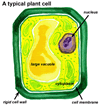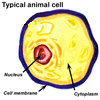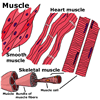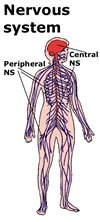|
Organisational relationships within
living things
There are four traditional levels of organisation in living things,
starting from the microscopic cells and increasing in complexity of
structure and function to tissues, organs and systems.
Cells
Cells are the most basic unit of structural organisation
within living things. It can be said that cells are the characteristic
feature that distinguish between living and non-living material.
 Cells are made up of many parts, called organelles, which are specialised
to do a specific job. The cell membrane allows essential materials to
move in and out of the cell. The nucleus contains genetic material that
determines an organism's chemical and physical characteristics. These
are common to both animal and plant cells, but the plant cell also has
a rigid cell wall that maintains the cell's shape, and some have chloroplasts
to capture the Sun's energy in photosynthesis to produce sugars.
Cells are made up of many parts, called organelles, which are specialised
to do a specific job. The cell membrane allows essential materials to
move in and out of the cell. The nucleus contains genetic material that
determines an organism's chemical and physical characteristics. These
are common to both animal and plant cells, but the plant cell also has
a rigid cell wall that maintains the cell's shape, and some have chloroplasts
to capture the Sun's energy in photosynthesis to produce sugars.
 Cells vary in their shape and function. Humans have over twenty
different forms such as skin, muscle, and fat-storing cells. They all
differ in structure
Cells vary in their shape and function. Humans have over twenty
different forms such as skin, muscle, and fat-storing cells. They all
differ in structure  to
allow them to perform their specific functions. to
allow them to perform their specific functions.
Some living things like bacteria  consist
only of one cell. Their organisational structure is very simple. Due
to their small size, they do not have tissues, organs and systems like
more complex animals and plants. Others in this category are protists
such as paramecium and euglena (See The
five kingdoms of living things). consist
only of one cell. Their organisational structure is very simple. Due
to their small size, they do not have tissues, organs and systems like
more complex animals and plants. Others in this category are protists
such as paramecium and euglena (See The
five kingdoms of living things).
Tissues
 Similar cells working together are collectively called a tissue.
An example of a tissue is muscle, such as cardiac muscle in the heart.
Other animal tissues are nerve, bone and skin (epithelial tissue). Examples
of plant tissues are xylem which transports water around a plant, and
phloem which transports sugars made in the leaves to all parts of the
plant.
Similar cells working together are collectively called a tissue.
An example of a tissue is muscle, such as cardiac muscle in the heart.
Other animal tissues are nerve, bone and skin (epithelial tissue). Examples
of plant tissues are xylem which transports water around a plant, and
phloem which transports sugars made in the leaves to all parts of the
plant.
Organs
In most plants and animals, tissues are grouped together to form organs.
An organ is a complicated structure that has a particular function.
An example in animals is the heart that pumps blood around the body.
It consists of tissues called cardiac muscle, and connective tissue
(e.g. ligaments and valves). In plants, the root is an organ which takes
up nutrients and water from the soil. It is made up of xylem, phloem
and other simple tissues such as parenchyma tissue. The pistil of the
flower is the female reproductive organ.
Systems
 Systems are made up of a set of organs that work together with
a common overall function. In humans there are several systems each
with its own specific role. These include the skeletal, muscular, endocrine,
reproductive, digestive, respiratory, circulatory, excretory and nervous
systems. Complex systems allow an organism to be very much larger and
to survive in a wider range of habitats which pose greater environmental
problems (see also Systems,
transport and exchange).
Systems are made up of a set of organs that work together with
a common overall function. In humans there are several systems each
with its own specific role. These include the skeletal, muscular, endocrine,
reproductive, digestive, respiratory, circulatory, excretory and nervous
systems. Complex systems allow an organism to be very much larger and
to survive in a wider range of habitats which pose greater environmental
problems (see also Systems,
transport and exchange).
The circulatory system consists of the heart, the blood vessels, lymph
vessels and blood. Together they ensure transport of nutrients and wastes
throughout the organism.
An organism's parts do not work in isolation. Its cells, tissues, organs
and systems must work together to keep it in optimum condition and ultimately
to keep it alive.
|